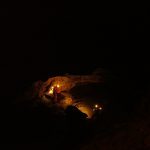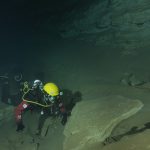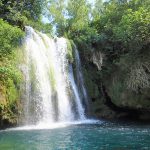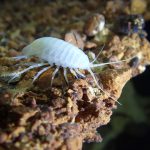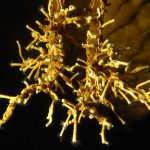Jazinka and Oziđana pećina cave
On the left bank of the Krka River, there are two exceptional caves thanks to the archaeological discoveries found within them.
Oziđana pećina cave (meaning Walled cave) is found at the top of the cliff of the Krka River Canyon above Roški slap waterfall. The cave has a simple morphology, and it was formed in the ceiling structure of horizontal layers shaped in conglomerate deposits. The cave is 59 metres long, and composed of one channel 5 to 10 metres wide, with two nearly vertical channels (chimneys) that do not reach the surface. The cave was named after the drystone wall at its entrance.
Given its morphology, external weather conditions have a strong influence on the microclimate inside the cave, seen by the drop in humidity and increasing air temperature in the cave during the summer months.
The average air temperature in the cave at a site off the marked trail, i.e., not exposed to artificial light, is 16.1°C, while the mean relative humidity is about 95.5%. The cave is mostly dry even in the wettest conditions, with visible percolation visible only at a few sports where small tubelike stalactites and flowstones have formed, with spreading stalagmites on the floor underneath.
Numerous ceramic fragments have been found in the cave, clearly indicating the presence of all Neolithic cultures of the Adriatic area (Impresso, Danilo and Hvar cultures), and of the Eneolithic period and Early and Middle Bronze Age. This proves the continuous human presence in the cave from the Early Neolithic period, from about 5000 until about 1500 B.C.
Important discoveries have been made within the cave such as flint artefacts (small knife), stone tools (hand-held millstone), bones of various animals (sheep, deer, wildcat) and fragments of mussel shells. Two children’s skeletons were unearthed, lying in the foetal position on the right side, like a child in a mother’s womb. According to their position in the vertical stratigraphy, they belong to the Neolithic period.
To date, 36 invertebrate taxa have been identified in Oziđana pećina cave, belonging to 19 higher systematic categories: mites (Acari), microwhip scorpions (Palpigradi), spiders (Araneae), centipedes (Chilopoda), beetles (Coleoptera), springtails (Collembola), millipedes (Diplopoda), true flies (Diptera), snails (Gastropoda), isopods (Isopoda), butterflies and moths (Lepidoptera), annelids (Anelida), harvestmen (Opiliones), grasshoppers and crickets (Orthoptera), pseudoscorpions (Pseudoscorpiones), booklice (Psocoptera), scorpions (Scorpiones), bristletails (Diplura) and silverfish (Thysanura).
The springtails are the dominant groups, followed by crickets, spiders and isopods. These four groups together account for 84% of the total cave fauna. The cave is also habitat for bats. The cave has been equipped and is open for visitors as part of the educational walking trail Stinice – Roški slap waterfall – Oziđana pećina cave.
The Jazinka cave is found in the canyon downstream of the Nečven fortress, at an elevation of 216 metres. The cave morphology is simple. It is 42 metres long, 4 metres deep, with a 12-metre vertical difference. After the low entrance, it opens onto a hall that continues in a 20-metre channel with many speleothems. The front part is dry, while the back end of the cave is very wet due to seeping and percolating water. Clayey sediment is present on the floor of most of the cave, and partly also on the cave walls.
The seasonal changes most affect the entrance part of the cave, as expected due to its morphology. The cave areas furthest from the entrance feature true cave conditions, with constant air temperature with a mean value of about 12.5°C.
Ceramic fragments dating to the Bronze and Late Iron Ages, animal bones, bronze arrows, a bronze fibula, twisted bronze torc necklace with chain have been found in the front part of the cave. Deeper in, human bones, glass paste beads, bronze spiral pendant, hooks and bronze needles have been found. The front part of the cave was likely used for housing, while the back part of the cave was a burial site.
To date, 29 taxa have been identified in the Jazinka cave, from the groups snails (Gastropoda), spiders (Araneae), pseudoscorpions (Pseudoscorpiones), harvestmen (Opiliones), mites (Acari), isopods (Isopoda), centipedes (Chilopoda), millipedes (Diplopoda), springtails (Collembola), bristletails (Diplura), beetles (Coleoptera), booklice (Psocoptera), true flies (Diptera), grasshoppers and crickets (Orthoptera) and butterflies and moths (Lepidoptera).
Among them are numerous taxa that are endemic to the Dinarides and Croatia. The troglobiont springtail species, Verhoeffiella margusi, is stenoendemic to Krka National Park, and the Jazinka cave is the type locality.
Photo: Mario Romulić & Dražen Stojčić



